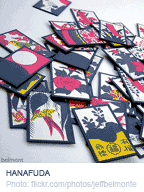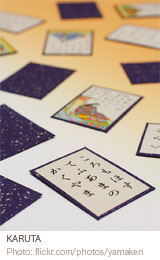Learn about some traditional Japanese games in Shizu’s story on Japanese Games.

Spending Your Free Time
During お正月 (おしょうがつ – o-shougatsu – New Year Days), since nowadays lots of places are open, you can rent a DVD or video at ビデオ・ショップ (bideo shoppu – video shop), buy hot food at コンビに (conbini – convenience store), enjoy special バーゲンセール (baagen seeru – burgain sale) for お正月 (New Year Days) at デパート (depaato – department store) and so on. But before, most shops and stores were closed during these days, and we used to enjoy some different indoor 遊び (あそび – games/pastime) at home. Of course we also used to play outside, but when you live in a snowy region like here in Hokkaido, you can often be trapped inside the house by heavy snow.
はなふだ – Hanafuda
 The meaning of 花札 (はなふだ – hanafuda) is literally “flower cards”, and it’s a set of 48 flower cards. Possibly you might see the cards in a Japanese film, and some shady people like “yakuza” were playing wih these cards? Yes, the cards have been used for gambling. I’m not exactly sure how the cards are used in other areas, but at least here in Hokkaido 花札 (flower cards) are one of the games played especially during the New Year days. When I was a high school student, some students took these cards on a school trip, and our classroom teacher was so upset and said, “Do you know WHAT KIND OF PEOPLE play this game?!”. The teacher came from Tokyo, and it was really shocking for him to find students were playing with the cards. And that made us laugh, lol.
The meaning of 花札 (はなふだ – hanafuda) is literally “flower cards”, and it’s a set of 48 flower cards. Possibly you might see the cards in a Japanese film, and some shady people like “yakuza” were playing wih these cards? Yes, the cards have been used for gambling. I’m not exactly sure how the cards are used in other areas, but at least here in Hokkaido 花札 (flower cards) are one of the games played especially during the New Year days. When I was a high school student, some students took these cards on a school trip, and our classroom teacher was so upset and said, “Do you know WHAT KIND OF PEOPLE play this game?!”. The teacher came from Tokyo, and it was really shocking for him to find students were playing with the cards. And that made us laugh, lol.
Apart from that, the card game is quite interesting. The cards have 12 sorts of 花 (はな – hana – flower), and each of the flowers has four cards. For example, there are four cards with pictures of 桜 (さくら – sakura – cherry blossoms), but each of the four cards has a different picture and is worth a different number of points in the game. The prettiest one is worth 20 points, the next one 5 points, and the remaining two cards have no points. But if you have lots of such “no points” cards by the end of the game, you might get big points.
Each of the 12 flowers (and trees) signifies a specific month. For example, 松 (まつ – matsu – pine tree) for January, 桜 (cherry blossoms) for March etc. Since they look colorful, playing with them is pleasant. The game has two or three 参加者 (さんかしゃ – sankasha – participants), depending on how it is played. Thus, if there are four people there and they have only one set of 花札 (flower cards), one person has to wait until one of the other three loses the game. When I was a child, my grandma always used to wait after me ![]()
I won’t give the ルール (rules) in detail, but the main idea is to gather pairs of the same suit (flower). The game with two people is more thrilling and interesting as a gambling game like poker, and the three person game is more peaceful.
かるた – Karuta
 The word apparently comes from ポルトガル (porutogaru – Portugal) originally. If you’re familiar with Japanese history, you might know that some Western things were introduced from ポルトガル (Portugal) and オランダ (oranda – The Netherlands) some time ago. かるた means “card” originally, but this Japanese word reminds us of specific cards called いろはがるた (irohagaruta), which means “Japanese alphabet cards” or something like that. Some of you already know that the Japanese “alphabet” is “あいうえお (a i u e o)”, but before, it used to be “いろは (i ro ha)” instead.
The word apparently comes from ポルトガル (porutogaru – Portugal) originally. If you’re familiar with Japanese history, you might know that some Western things were introduced from ポルトガル (Portugal) and オランダ (oranda – The Netherlands) some time ago. かるた means “card” originally, but this Japanese word reminds us of specific cards called いろはがるた (irohagaruta), which means “Japanese alphabet cards” or something like that. Some of you already know that the Japanese “alphabet” is “あいうえお (a i u e o)”, but before, it used to be “いろは (i ro ha)” instead.
Each of いろはがるた (cards for i ro ha) contains a 諺 (ことわざ – kotowaza – proverb). One proverb begins with the letter い, the next proverb with the letter ろ, and so on.
Well, apart from the set of the proverbs, there is another set of cards which has the first letter of the proverbs and a drawing that corresponds to it. For example, the proverb which begins with the letter い is:
犬も歩けば棒に当たる。
いぬもあるけばぼうにあたる。
Inu mo arukeba bou ni ataru.
One card has only the sentence above, and another one which corresponds with it has only the letter い and the picture of a dog. The latter set of cards are put on the floor, and the 参加者 (participants) sit down around the cards. Only one person holds another set which has proverbs, and he or she reads the proverbs out loud. The 参加者 (participants) start to look for the card which matches the proverb among the cards on the floor as soon as they hear it, and the person who touches the card first can get it. After that, the next card is read, and the game continues until the floor is empty. The winner is the person who has the most cards, and sometimes you can also win a 賞品 (しょうひん – shouhin – prize) if the game is part of a bigger event.
Thus, the game is quite simple. But it needs speed, and sharp and exact action to get the proper card, and you should take care not to be injured, lol. Children often argue over a card, insisting “It’s mine!”, and even adults may do this if the winner gets a 賞品 (prize).
福笑い – ふくわらい – fukuwarai
This is a really simple game, and you don’t need to worry about quick reflexes or intelligence. On a big piece of paper which has a drawing of the outline of a face, you arrange some parts such as 目 (め – me – eye), 眉毛 (まゆげ – mayuge – eyebrow), 鼻 (はな – nose), 口 (くち – kuchi – mouth). You have to do it with a blindfold, so nobody knows how funny or terrible the face looks until it is completed. People around you may laugh a lot while looking at your “art”, and you may get some hints from the laughter.
“福 (ふく – fuku)” means “happiness”, and “笑い (わらい – warai) means “laugh/laughter”. We have a saying which means “laughter invites happiness” or something like that, so please laugh a lot so that happiness will visit you ![]()
Note
Recently some different かるた are sold at toy shops and book stores, and so on. For example, there are かるた depicting TV show or anime characters. In such かるた, each of the picture かるた has a character, and the other set has sentences which describe the characters instead of proverbs, as above. It sounds ridiculous for adults, but it is welcomed by little children, especially when they are great fans of the characters.